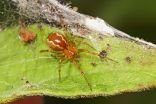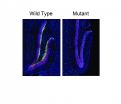(Press-News.org) LANSING, Mich. October 1, 2014 – Tart cherries have long been researched for their association with pain relief – ranging from gout and arthritis joint pain to exercise-related muscle pain. A new study published in the Journal of Functional Foods is the first to report consumption of Montmorency tart cherries caused changes in uric acid metabolism, which can have an impact on joint pain. The study also detected increases in specific anthocyanin compounds in the bloodstream after consuming tart cherries.
In the study, Montmorency tart cherry juice reduced blood levels of uric acid and C-reactive protein, a measure of inflammation. High levels of uric acid are linked to gout, a form of arthritis that can cause severe attacks of intense pain and swelling (inflammation) in various joints, including the big toe and other joints in the legs and arms.
A research team led by Dr. Glyn Howatson with PhD student Phillip Bell in the Department of Sport, Exercise and Rehabilitation at Northumbria University in the UK gave 12 healthy participants (average age 26 years) two doses of Montmorency tart cherry juice concentrate: about 1 ounce (30 ml) of the juice concentrate mixed with 100 ml of water (equivalent to 90 whole Montmorency tart cherries) or 2 ounces (60 ml) of juice concentrate mixed with 100 ml of water.
The researchers used a single blind, two-phase, randomized, cross-over design to identify the bioavailability of anthocyanins following the consumption of these two different doses. There was a washout period of at least 10 days between the phases. Each phase was comprised of two days drinking the tart cherry juice concentrate twice a day – in the morning and just before dinner.
The researchers collected blood and urine samples from the participants immediately before and at numerous intervals for 48 hours after the tart cherry juice was consumed. The results supported the researchers' hypothesis: blood levels of uric acid and C-reactive protein were reduced and urinary uric acid was increased following both doses of the tart cherry juice. The magnitude of the change was independent of the dose given; that is, the 30 ml of the juice was just as effective as 60 ml.
"We have been investigating Montmorency tart cherries for several years because they're a unique fruit with a high concentration of anthocyanins," said co-author Howatson, whose previous studies have demonstrated the ability of tart cherry juice to reduce certain inflammation responses and oxidative stress after high-intensity exercise. "Our current study was conducted with a healthy population, although more research is needed to determine the specific benefits of Montmorency tart cherry juice for individuals with inflammatory diseases, including gout and other arthritic conditions."
A second study newly published in the Journal of Functional Foods conducted by Dr. E. Mitchell Seymour and Dr. Sara M. Warber from the University of Michigan found that the antioxidant capacity in the blood was elevated after eating whole frozen Montmorency tart cherries (45 or 90 cherries), and remained elevated even 12-hours after eating the 90 cherries. Similar to the Howatson team in the UK, they also observed tart cherry anthocyanin metabolites in the blood and urine with both doses of the whole tart cherries.
"Our observations were after a one-time consumption," said lead author Seymour. "It is compelling to think what could occur with more regular consumption of tart cherries, and how that could translate into possible health benefits."
Montmorency tart cherries are available year-round in dried, frozen and juice forms --including juice concentrate, which was the form used in the UK study. Montmorency tart cherry juice concentrate can be mixed with water or other juices. It can also be consumed straight from the bottle or used as an ingredient in recipes, including smoothies and other beverages.
INFORMATION:
The Cherry Marketing Institute, a not-for-profit organization, provided financial support for the UK analysis of anthocyanins and high sensitivity C-reactive protein, a marker of inflammation. All other elements of the study were funded by Northumbria University, UK. The funders had no role in the study design, data collection and analysis, decision to publish or preparation of the manuscript. The Seymour et al. study was supported by an unrestricted grant from the Cherry Marketing Institute and the University of Michigan Clinical Research Unit of the Michigan Institute for Clinical and Health Research from the U.S. National Institutes of Health.
For more information on the growing body of research on Montmorency tart cherries, visit http://www.choosecherries.com.
Sources:
Bell PG, Gaze DC, Davison GW, George TW, Scotter MJ, Howatson G. Montmorency tart cherry (Prunus cerasus L.) concentrate lowers uric acid, independent of plasma cyanidin-3-O-glucosiderutinoside. Journal of Functional Foods. 2014; 11: 82-90.
Bell PG, Walshe IH, Davison GW, Stevenson E, Howatson G. Montmorency cherries reduce the oxidative stress and inflammatory responses to repeated days high-intensity stochastic cycling. Nutrients. 2014;6:829-843.
Seymour EM, Warber SM, Kirakosyan A, Noon KR, Gillespie B, Uhley VE, Wunder J, Urcuyo DE, Kaufman PB, Bolling SF. Anthocyanin pharmacokinetics and dose-dependent plasma antioxidant pharmacodynamics following whole tart cherry intake in human adults. Journal of Functional Foods. Sept. 2014; published online ahead of print.
MINNEAPOLIS/ST PAUL (October 1, 2014) – Researchers at the University of Minnesota have identified microRNAs that may cause colon polyps from turning cancerous. The finding could help physicians provide more specialized, and earlier, treatment before colon cancer develops.
The findings are published today in The Journal of Pathology.
The American Cancer Society estimates over 134,000 people will be diagnosed with colon cancer in 2014, despite the expanded screening processes now available. This year alone, about 50,000 people will die because of the disease.
Research ...
New Rochelle, NY, October 1, 2014—The cause of fibromyalgia, a chronic pain syndrome is not known. However, the results of a new study that compares brain activity in individuals with and without fibromyalgia indicate that decreased connectivity between pain-related and sensorimotor brain areas could contribute to deficient pain regulation in fibromyalgia, according to an article published in Brain Connectivity, a peer-reviewed journal from Mary Ann Liebert, Inc., publishers. The article is available free on the Brain Connectivity website at http://online.liebertpub.com/doi/full/10.1089/brain.2014.0274 ...
Along rivers in Tennessee and Georgia, scientists have been studying brownish-orange spiders, called Anelosimus studiosus, that make cobwebby nests "anywhere from the size of a golf ball to the size of a Volkswagen Beetle," researcher Jonathan Pruitt says. The individual spiders are only the size of a pencil eraser, but they form organized groups that can catch prey ranging from fruit flies to small vertebrates. "We have found carcasses of rats and birds inside their colonies," Pruitt says. Unlike most spiders, which are solitary, these social spiders work together in groups.
Now ...
COLUMBIA, Mo. – Breathing oxygen helps the body create energy for its cells. As a result of the breathing process, reactive molecules called "free radicals" are produced that often cause damage to proteins and genes found in cells. This damage is known as oxidative stress. Free radicals also have been linked to cancer, Alzheimer's and Parkinson's disease. Now, investigators at the University of Missouri have discovered a molecule that treats oxidative stress.
"Oxidative stress can cause damage to the building blocks of a cell, resulting in excessive cell proliferation, ...
For older adults, being unable to identify scents is a strong predictor of death within five years, according to a study published October 1, 2014, in the journal PLOS ONE. Thirty-nine percent of study subjects who failed a simple smelling test died during that period, compared to 19 percent of those with moderate smell loss and just 10 percent of those with a healthy sense of smell.
The hazards of smell loss were "strikingly robust," the researchers note, above and beyond most chronic diseases. Olfactory dysfunction was better at predicting mortality than a diagnosis ...
ALEXANDRIA, VA — The American Academy of Otolaryngology—Head and Neck Surgery Foundation has released the first ever mutli-disciplinary, evidence-based clinical practice guideline to improve the diagnosis and management of tinnitus, the perception of sound—often ringing—without an external sound source. The guideline was published today in the journal Otolaryngology–Head and Neck Surgery.
"Tinnitus affects 10-15% of adults in the United States. It is the most common service-related disability among our military veterans. Yet despite its prevalence and effect on quality ...
For older adults, being unable to identify scents may be a predictor of mortality within five years, according to a study published October 1, 2014, in the journal PLOS ONE by Jayant Pinto from The University of Chicago and colleagues.
The study was part of the National Social Life, Health and Aging Project (NSHAP), the first in-home study of social relationships and health in a large, nationally representative sample of men and women ages 57 to 85. Researchers first surveyed 3,000 participants in 2005-06, assessing their ability to identify five distinct common odors, ...
Studying mice with a genetic change similar to what is found in Kabuki syndrome, a inherited disease of humans, Johns Hopkins researchers report they have used an anticancer drug to "open up" DNA and improve mental function.
Along with a potential treatment for the intellectual disability seen in Kabuki syndrome, the study's findings also suggest a new way of thinking about a category of genetic diseases known as Mendelian disorders of the epigenetic machinery, the researchers say. In these disorders, a genetic mutation causes errors in the way proteins and chemicals ...
Researchers have identified a molecular mechanism that could explain why the common cold can bring on life-threatening asthma attacks.
Published today in Science Translational Medicine, the findings indicate this may be a potential target for new drugs that could be more effective than existing treatments.
Viruses that infect the airways are the most common cause of asthma attacks, accounting for 80-90 per cent of cases. The great majority of these are rhinoviruses, which are the predominant cause of the common cold.
Although illnesses caused by rhinoviruses are ...
Scientists at the University of Southampton have discovered that a region on the front surface of the eye harbours special stem cells that could treat blinding eye conditions.
This part of the eye is called the 'corneal limbus' and is a narrow gap lying between the transparent cornea and white sclera.
The research, published in PLOS ONE, showed that stem cells can be cultured from the corneal limbus in vitro. Under the correct culture conditions, these cells could be directed to behave like the cells needed to see light - photoreceptor cells.
The loss of photoreceptors ...





